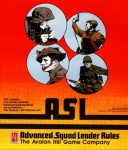 Rolling for Initiative is a weekly column by Scott Thorne, PhD, owner of Castle Perilous Games & Books in Carbondale, Illinois and instructor in marketing at Southeast Missouri State University. This week, Thorne looks at why wargames don't sell better.
Rolling for Initiative is a weekly column by Scott Thorne, PhD, owner of Castle Perilous Games & Books in Carbondale, Illinois and instructor in marketing at Southeast Missouri State University. This week, Thorne looks at why wargames don't sell better.We were going through a stack of old SPI wargames, and when I say old, I mean mid-1970s era, checking to make certain that they had all the counters, maps, instructions and tables. It started me thinking about how few historic war games sell today. We have a number of out of print SPI, Avalon Hill and GMT wargames in stock as well as a good selection of currently in-print materials. However, with the exception of Axis and Allies, a comparatively uncomplex game (at least compared to games such as Advanced Squad Leader, Up Front and Kingmaker), we don't sell wargames. We don't even sell the thirty and forty year old SPI and Avalon Hill games that draw fond reminiscences of hours spent playing from our older customers. People look at the ones we have on display and older customers reminisce about playing them in their younger days, but, unlike those games who reminisce about playing D&D, the wargame nostalgics never buy the games of which they speak so fondly.
The major reason for this, it seems to me, ties peripherally into a news story I heard this week on sales declines in the video game industry. Despite what appears as record sales and top selling titles, with customers salivating for the next immersive or first person shooter release, video game sales dropped 20% last year, continuing a steady decline over the past several years. The reason for this, according to the story, is the mushy middle. Customers willingly shell out $60 to $70 for top line game releases such as Halo and Resident Evil and equally willingly spend a buck or two (or nothing) for Angry Birds or Game Type (or anything on Facebook). The games taking the hits and causing the decline are the ones in the middle, the $30 and $40 titles that people would buy to fill time after they finished that big $60 game. Increasingly, instead of dropping $30 on a mid-level title, players move to the cheap quick games such as Angry Birds, which they pay a buck for and play while standing in line at the grocery store or on the bus on the way to work. They nicely fill small bits of time and players feel they got a good value for their money. They also feel they got a good value in the sixty dollar game as well, just not from the $40 game.
It struck me that we have somewhat of a similar problem in the boardgame industry, save that we don't have the $1 slice of time games. Instead, it's all about the time. Customers buy familiar games that take one to two hours to play. A comment we hear over and over about the historic wargames is "Yeah I played that years ago. It took us two hours just to set up the board." Players don't want or even have that amount of time to commit in the quantity necessary to play a historic wargame. They want games they can easily play with a couple of friends, without rulebooks that are 40+ pages thick and that finish in about 60 minutes (I see there is even a magazine seeking funding on Kickstarter titled Casual Game Insider targeted at just this category of games). That's why we sell dozens of Settlers of Catan for every copy of Queen of the Celts or even Tide of Iron that moves off the shelf. Of course, the lack of advertising and publicity for almost all historic wargames doesn't help matters either. The one wargame line that does move fairly regularly for us is Dan Versson Games, and even then, it is DVG's solitaire games that outsell the others. Even with DVG, it is a matter of time. Unlike most wargames, and board games, for that matter, the solitaire wargame allows the player to have an opponent any time desired, which, come to think of it, is a major selling point of the online game as well. Playing the Internet gives you an opponent twenty-four hours a day.
The opinions expressed in this column are solely those of the writer, and do not necessarily reflct the views of the editorial staff of ICv2.com.


